Firebomb Dungpile Japs Again and Again and Againto Extinction
One American general called the Battle of Iwo Jima "the most savage and the most costly battle in the history of the Marine Corps."
U.S. Marines finally invaded the island of Iwo Jima on February 19, 1945 after months of naval and air bombardment. National Archives/CORBIS/Corbis via Getty Images
U.S. soldiers unload supplies shortly after their invasion of Iwo Jima. US Coast Guard/US Coast Guard/The LIFE Picture Collection/Getty Images
Marines employ mobile rocket units against Japanese forces. Corbis via Getty Images
Japanese soldiers lie dead in a shell hole near the airfield. Corbis via Getty Images
Two Marines inspect the corpse of a Japanese soldier. W. Eugene Smith/The LIFE Picture Collection/Getty Images
The mangled corpse of a Japanese defender at Iwo Jima. W. Eugene Smith/The LIFE Picture Collection/Getty Images
Bodies of dead Marines from the 3rd Marine Division lie covered on stretchers as they await to be identified. PhotoQuest/Getty Images
U.S. Marine Corps motion picture cameraman Sgt. Bill Genaust (left) poses with Cpl. Atlee Tracy. Genaust had filmed the famous Iwo Jima flag-raising the day before. Bob Campbell/PhotoQuest/Getty Images
Marines landing on Iwo Jima. Joseph Schwartz/Corbis via Getty Images
U.S. Marines brace for impact after a massive explosion. W. Eugene Smith/The LIFE Picture Collection/Getty Images
U.S. soldiers showing captured Japanese flags. Keystone/Getty Images
U.S. Marines advance amid assault from the Japanese at Iwo Jima. Keystone-France/Gamma-Keystone via Getty Images
A few of the 216 surviving Japanese soldiers. Central Press/Getty Images
Navy nurse Jane Kendiegh helping an injured soldier at Iwo Jima. Getty Images
A wounded soldier is helped to the beach so that a landing craft can take him to a hospital ship. Getty Images
Cpl. Edward Burckhardt with the kitten he said "captured him" at the base of Suribachi Yama. Corbis via Getty Images
View of the American forces landing on Iwo Jima. US Navy/US Navy/The LIFE Picture Collection/Getty Images
A soldier relieves himself as he stands on a hilltop overlooking the devastation from the Battle of Iwo Jima. Corbis via Getty Images
American soldier with a courier dog. Getty Images
Injured Marine being helped by other soldiers. Getty Images
U.S. soldiers armed with flame throwers advance. Corbis via Getty Images
Wounded Marines await evacuation to Guam. Corbis via Getty Images
Amphibious attack vehicles land for battle. Ed Clark/The LIFE Picture Collection/Getty Images
Soldiers raise the first American flag atop Mt. Suribachi at Iwo Jima. Lou Lowery/US Navy/Getty Images
Pair of American Marines survey the view from atop Mt. Suribachi two days after the famous flag raising. US Marine Corps/US Marine Corps/The LIFE Picture Collection/Getty Images
Handling rockets aboard USS LCI 708, flagship of LCI Task Force 51.15.3 during Iwo Jima. National Archives
U.S. Marines sitting in foxholes. PhotoQuest/Getty Images
Marines taking a photo with the American flag.
Four soldiers carrying an injured Marine at Iwo Jima. Keystone-France/Gamma-Keystone via Getty Images
Observer who spotted a machine gun nest finds its location on a map so they can send the information to artillery. CORBIS/Corbis via Getty Images
U.S. Marines on the beaches of Iwo Jima. W. Eugene Smith/The LIFE Picture Collection/Getty Images
Marines showing off captured Japanese flag at Iwo Jima. Cornelius/PhotoQuest/Getty Images
View from warplanes above Iwo Jima.
U.S. Marines stand beside the American flag planted atop Mt. Suribachi at Iwo Jima, the second flag that was raised that day. PhotoQuest/Getty Images
Photographer Joe Rosenthal captured the iconic image of American soldiers raising the flag on Iwo Jima. Associated Press
Soldiers taking down the first, smaller American flag at Iwo Jima as the more famous, bigger flag is being raised in the background. Louis R. Lowery/US Marine Corps/The LIFE Picture Collection/Getty Images
American naval troops take aim near Iwo Jima.
Marines standing around the famous Iwo Jima flag. PhotoQuest/Getty Images
View of the massive U.S. naval armada at Iwo Jima.
American vessel delivers troops and vehicles to Iwo Jima beach.
Marines attaching American flag to a pole at Iwo Jima. National Archives
Mount Suribachi as seen from an American vessel. National Archives
U.S. Marines charge from their beachhead positions against the enemy. National Archives
Stalled and stuck vehicles in soft volcanic ash on Iwo Jima beach. National Archives

How Tens Of Thousands Of Soldiers Died In The Bloody Battle Of Iwo Jima
The Battle of Iwo Jima stands out as one of the bloodiest encounters of the Pacific Theater of World War II. What American leadership estimated would take mere days stretched into five bloody weeks in a fight against the Japanese Imperial Army over a small volcanic island.
The U.S. objective was to seize the island, which had become a strategic site for the Japanese to launch counterattacks against the Americans. When the Battle of Iwo Jima ended on March 26, 1945, an estimated 7,000 U.S. Marines who had stormed the beaches were dead while another 20,000 were wounded.
Although the Japanese suffered more deaths — out of the 20,000 soldiers who took part in the battle, only 216 survived — Iwo Jima was the first Pacific War battle where the U.S. suffered greater total casualties than the Japanese.
Still, the U.S. massively outnumbered the Japanese from the start of the battle. Though the fight was long and brutal, there was no way the Americans could have lost.
The Pacific War
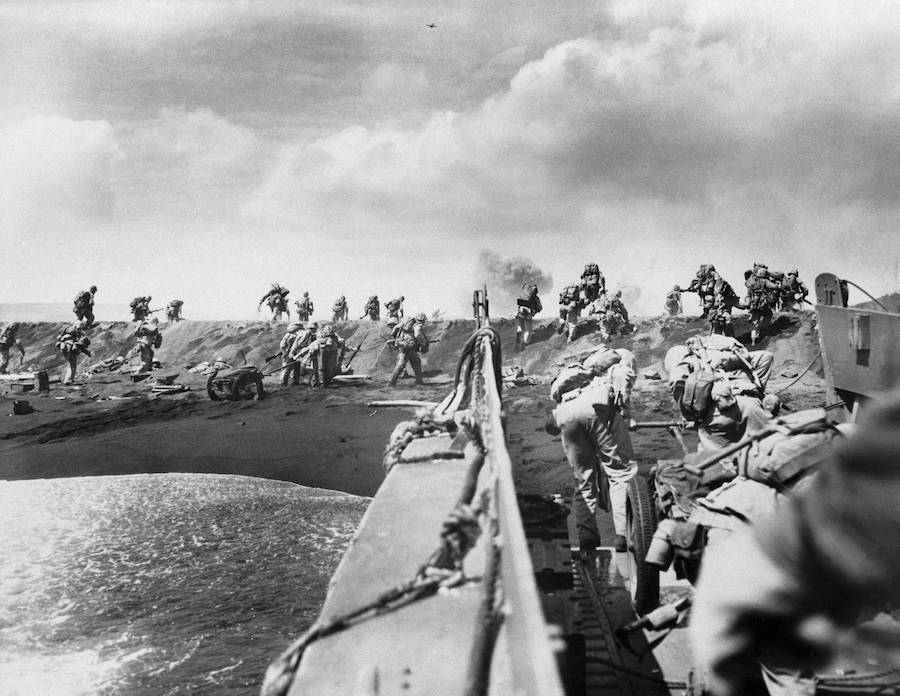
Getty Images U.S. soldiers storm the beaches of Iwo Jima. By the end of the battle, the U.S. suffered nearly 30,000 casualties.
In the summer of 1944, the Allies had been fighting tooth and nail against Japanese Imperial forces to liberate the Asia Pacific region. As part of their campaign to defeat the enemy, the U.S. launched an attack on the Mariana Islands, just south of Iwo Jima.
This successful campaign not only pushed back the Japanese but also opened up their homeland to aerial bombing. In particular, it allowed for the creation of new airbases that could accommodate the new B-29 "Superfortress" bombers, aka the planes that would eventually drop nuclear bombs on Hiroshima and Nagasaki.
The B-29 bombers caused massive damage, but the Japanese didn't sit idly by once the bombings began.
To counter the American air attacks, the Japanese built airstrips on the small Pacific island of Iwo Jima, located 700 miles south of Tokyo, and subsequently intercepted the B-29s. The Japanese were so effective that America's Twentieth Air Force lost more B-29s to raids from Iwo Jima than it did on its attacks over the Japanese homeland.
Edward R. Murrow presents a report on conditions at Iwo Jima.
Iwo Jima — which means "Sulfur Island" in Japanese — was a heretofore ignored, eight-square-mile volcanic mound, but it was strategically crucial: It sat almost exactly halfway between the Mariana Islands and the main Japanese island of Honshu. In order to succeed against the Japanese, the U.S. had to take the island.
American Military Superiority
American military leaders were dead set on capturing Iwo Jima. On October 3, 1944, the Joint Chiefs of Staff ordered Admiral Chester W. Nimitz, commander in chief of the U.S.'s naval fleet in the Pacific, to begin preparations for the island's capture in the early months of the following year. The campaign was code-named Operation Detachment and would become the largest combat employment of U.S. Marines in history.
At the crack of dawn on Feb. 19, 1945, 30,000 Marines poured onto the beaches of Iwo Jima in the first wave of the naval invasion. The second wave, approximately 20 minutes after the initial one, brought even more soldiers onto the small island. In total, approximately 70,000 U.S. Marines (though some estimates peg the number at 110,000) would be deployed to take part in the battle against 20,000 or so defending Japanese soldiers.
The U.S. clearly had strength in numbers and were led by highly experienced veterans of amphibious warfare.
On land, they were commanded by Marine Maj. Gen. Harry Schmidt, who led the V Amphibious Corps, comprised principally of the 3rd, 4th, and 5th Marine divisions. He was accompanied by the old warhorse Lt. Gen. Holland M. "Howlin' Mad" Smith of the U.S. Marine Corps.
Meanwhile, on water, Admiral Raymond A. Spruance commanded the U.S. Navy's Fifth Fleet, joined by Vice Admiral Richmond Kelly Turner presiding over Task Force 51, which comprised a fleet of nearly 500 ships, and Rear Admiral Harry Hill, who commanded Task Force 53.
But despite all of their combined experience and numerical and technological superiority, the Americans were not ready for what was about to happen.
The Battle Of Iwo Jima
American soldiers faced a deadly combination of difficult beach terrain and heavy enemy fire at Iwo Jima.
For starters, the soft black sands of Iwo Jima made it tough for landing vehicles and supplies to get through, as they easily sank into the ground.
More importantly, the Marines were greeted by overwhelming fire from Japanese forces that had blended themselves seamlessly into the interior of Iwo Jima's volcanic landscape. The tactic caught the American forces by surprise as it differed from the standard way of defending a shoreline.
"You could've held up a cigarette and lit it on the stuff going by," Lieut. Col. Justice M. "Jumpin' Joe" Chambers, who led the 3rd Battalion of the 25th Marines on the landing beaches, recalled. "I knew immediately we were in for one hell of a time."
By dusk, after the first landing force had been secured, roughly 2,400 U.S. soldiers had been killed or wounded. It became obvious that the Japanese had learned from their previous encounters with the U.S., allowing them to study their enemy's movements and draw up a new battle plan.
The Japanese Defense
That plan was orchestrated by Lieut. Gen. Tadamichi Kuribayashi, the Japanese commander at Iwo Jima. The disciplined Kuribayashi was a former cavalry officer who had a knack for picking up on flaws in past battle tactics and fixing them.
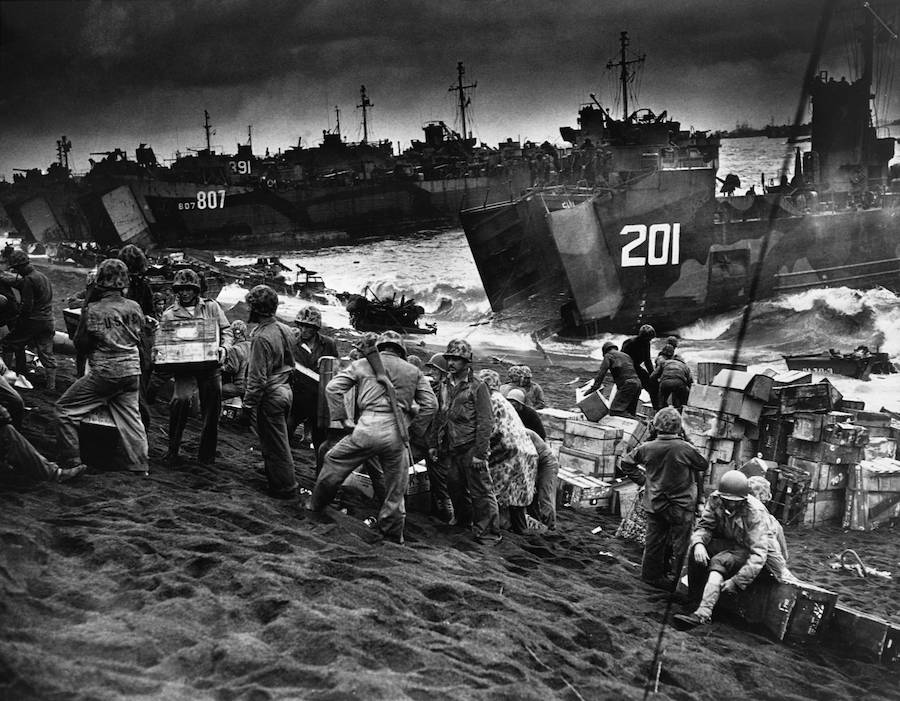
Corbis via Getty Images Troops unload supplies from Coast Guard and Navy landing craft on the black sandy beach of Iwo Jima.
Kuribayashi's military expertise was highlighted by his refusal to allow the suicidal banzai charge that the Japanese were famous for, which had previously been attempted at the Battle of Saipan.
Instead, Kuribayashi made the best use of the two major advantages he did have over the Americans at Iwo Jima: the element of surprise and a defensive position.
He ordered his forces to set up hidden guns that blended into the island's landscape and organized the creation of an expansive network of underground tunnels into Iwo Jima's soft sulfuric land, which offered increased protection.
Meanwhile, on the island's 554-foot-tall Mount Suribachi, Kuribayashi set up a seven-story high fortress. The structure was equipped with weapons, communications, and supplies, and offered his forces a vantage point against the invading U.S. troops. Much in part due to Kuribayashi's tactics, more than 500 U.S. Marines died on the first day of the Battle of Iwo Jima.
But as it often goes in battle, some things happened unexpectedly. Kuribayashi's soldiers at the slope of Mount Suribachi could not resist firing against the American forces during daylight.
This reckless move revealed their positions and the American forces took immediate advantage of the mistake, inflicting serious casualties against the Japanese gunners. U.S. forces would take over Mount Suribachi four days after the first landing, marking a pivotal development in the battle. One photojournalist's iconic photograph captured the moment — but there was still a whole month of fighting to go.
Four More Weeks Of Bitter Fighting
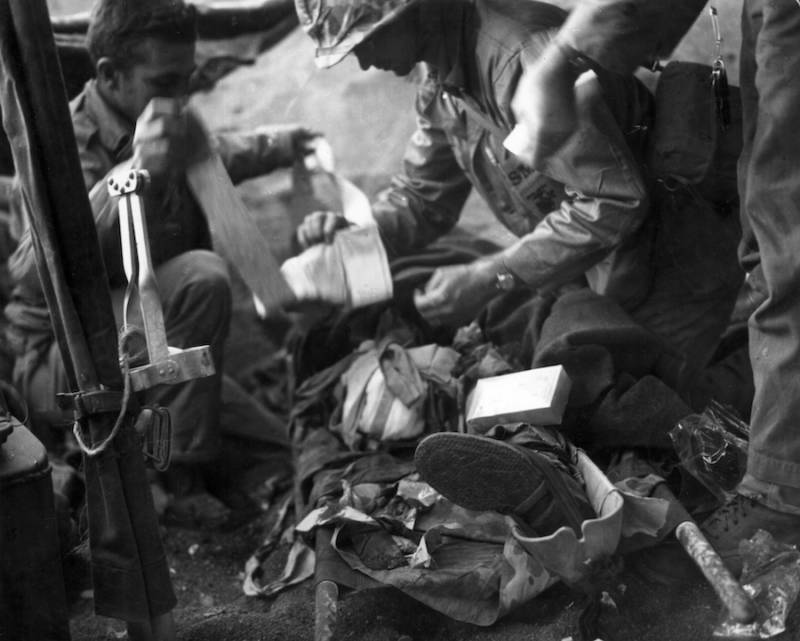
Joseph Schwartz/Corbis via Getty Images Medics bandage an amputee on Iwo Jima. What was supposed to be a quick campaign to take over the island took five bloody weeks.
The battle of Iwo Jima would last for another four bloody weeks as American forces fought for control of the northern part of the island. This fighting was characterized by Japanese forces firing out of their dug-in positions and tunnels and making offensive excursions during the night.
The Japanese proved so difficult to dislodge that the U.S. forces had to change up their strategy, focusing on flamethrowers and grenades to clear the tunnels instead of using more conventional tactics.
Gen. Smith came ashore frequently to assess battlefield conditions and would later remark that Iwo Jima was "the most savage and the most costly battle in the history of the Marine Corps."
On March 14, the U.S. forces reached Kitano Point on the northern coast of the island and again raised their country's flag, but the fighting raged on for another 12 days.
Kuribayashi is believed to have perished sometime in the wee hours of March 26, although it's unclear whether he committed hari-kiri (ritual suicide) or led his men in one final attack.
In any case, he seemed hopeless in his final dispatch from the island: In his eyes, his soldiers were fighting "with empty hands and empty fists" against an enemy of "unimaginable material superiority."
On March 26, General Schmidt announced that Operation Detachment was finally over. The Americans had successfully taken over Iwo Jima, but the victory came at a high cost. In total, the U.S. suffered almost 30,000 casualties compared to Japan's more than 19,000 dead, cementing Iwo Jima as the first battle where the U.S. suffered more casualties — though fewer deaths — than Japan.
As TIME combat correspondent Robert Sherrod put it:
"[American and Japanese soldiers] all died with the greatest possible violence. Nowhere in the Pacific war had I seen such badly mangled bodies. Many were cut squarely in half."
Raising The Flag On Iwo Jima
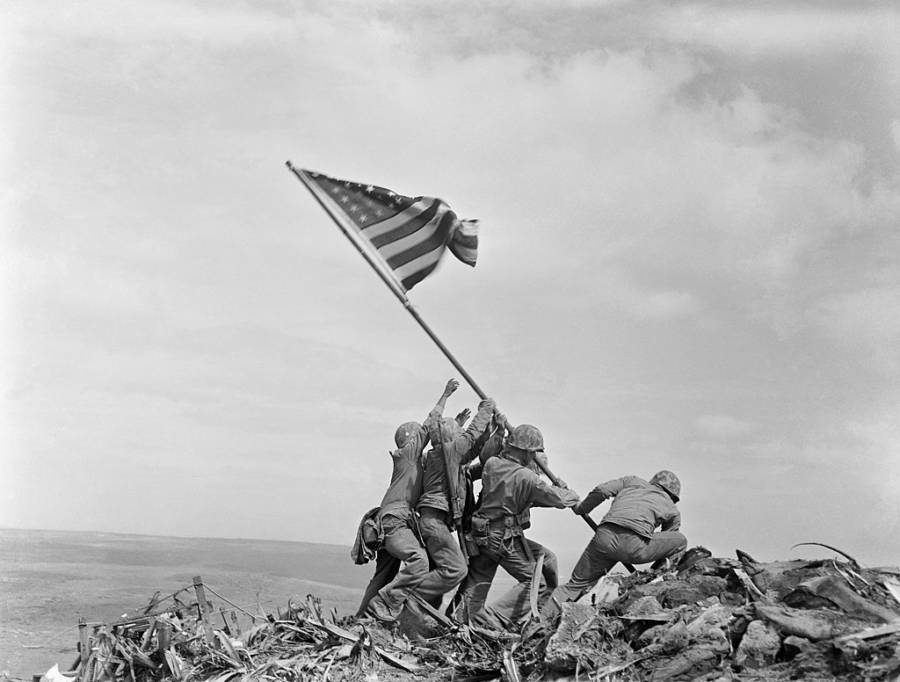
Associated Press/Wikimedia Commons Photographer Joe Rosenthal captured the famous image of American soldiers raising the flag on Iwo Jima.
The most enduring image of the Battle of Iwo Jima is the photograph of the U.S. flag being raised by a band of soldiers on Mount Suribachi. The iconic moment was captured by Associated Press photographer Joe Rosenthal, who followed a crew of soldiers to the top of the 554-foot hill.
But what most people don't know is that the flag in the picture was not the first one to be raised on the mountain. Apparently, after the first flag had been planted, the commanders realized it was too small and therefore difficult to spot for U.S. troops who were still fighting in the northern part of the island.
The top brass decided they needed a bigger flag. So, a rag-tag team of soldiers was formed to carry out the task.
The group was made up of six men: Michael Strank, Harlon Block, and Franklin Sousley died in combat days later, while René Gagnon, Harold Schultz, and Ira Hayes would live on.
Within 36 hours, the flag photo from Iwo Jima was on the front page of hundreds of publications around the world. The visual of a group of soldiers dutifully working together to raise the symbol of America was a striking image and won lasting adoration from the American public.
Iwo Jima Flag Controversy
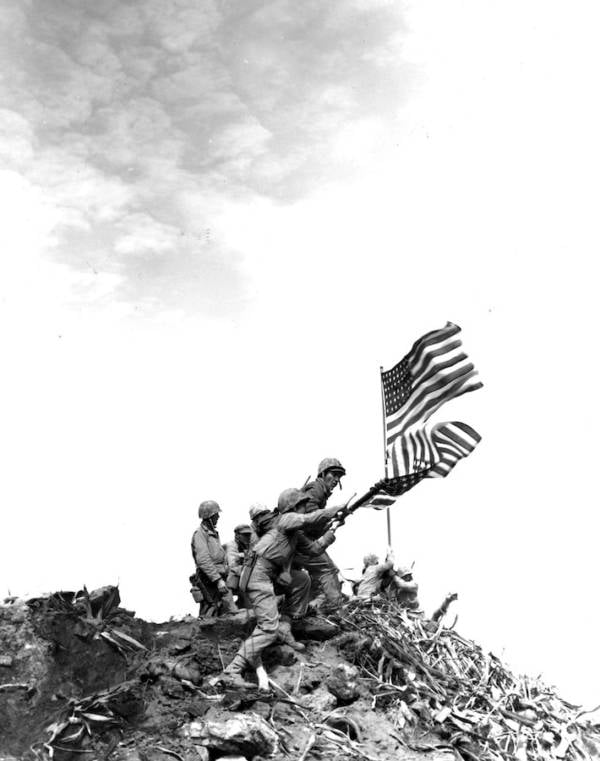
Universal History Archive/UIG via Getty Images After an American flag was successfully planted on Mount Suribachi, a larger flag was installed in its place to fuel the fighting troops below.
However, confusion over the two separate flag raisings remained. Some people even came to believe the popular photograph had been staged.
One problem was the account of wartime journalist Lou Lowery, who took a photo of the first flag raising. Lowery had not encountered Rosenthal's group on his way down from the mountain and did not recall seeing Rosenthal. In other words, he was not aware the second flag raising had happened.
Things were further muddled by an unverified TIME radio story on the "Time Views the News" program which reported that "Rosenthal climbed Suribachi after the flag had already been planted....Like most photographers, [he] could not resist reposing his characters in historic fashion."
Rosenthal would go on to spend much of his time defending the photograph's authenticity. Luckily, his account was corroborated by expert researchers. Rosenthal laid out his argument in an interview:
"Had I posed that shot, I would of course have ruined it... I'd have picked fewer men... I would have made them turn their heads so they could be identified [and] nothing like the existing picture would have resulted."
The Battle Of Iwo Jima On Screen
The best known cinematic adaptations of the Battle of Iwo Jima were the films Flags Of Our Fathers and Letters From Iwo Jima, both of which were directed by actor-turned-filmmaker Clint Eastwood and released two months apart in 2006.
The two movies told the story from different yet intersecting perspectives. Flags Of Our Fathers followed the stories of the six men captured in the iconic flag hoisting at Iwo Jima and their struggles in and after battle.
Meanwhile, Letters From Iwo Jima explored the gruesome island war from the Japanese perspective, particularly General Kuribayashi, portrayed by Japanese actor Ken Watanabe. Eastwood was inspired to make the movie after coming across the General's letters, which revealed his human side through writing to his daughter and showing an interest in learning English.
"As we were preparing to do Flags of Our Fathers, it occurred to me that the general who was the defender of the island was considered by American generals to be quite clever. And so I just started to get curious about as to what he was like. I asked a friend in Japan to send any books that were on him," Eastwood told NPR.
"There were no books in English but there was a small book about letters he had written home when he was an envoy in the United States and Canada in the late '20s to '30s. He had written home and drawn little pictures for his daughter to show them what it was like, where he was. I thought, 'this is an interesting person.'"
Both films have been listed on a number of "best movies" lists and received critical acclaim.
Flags Of Our Fathers Criticism
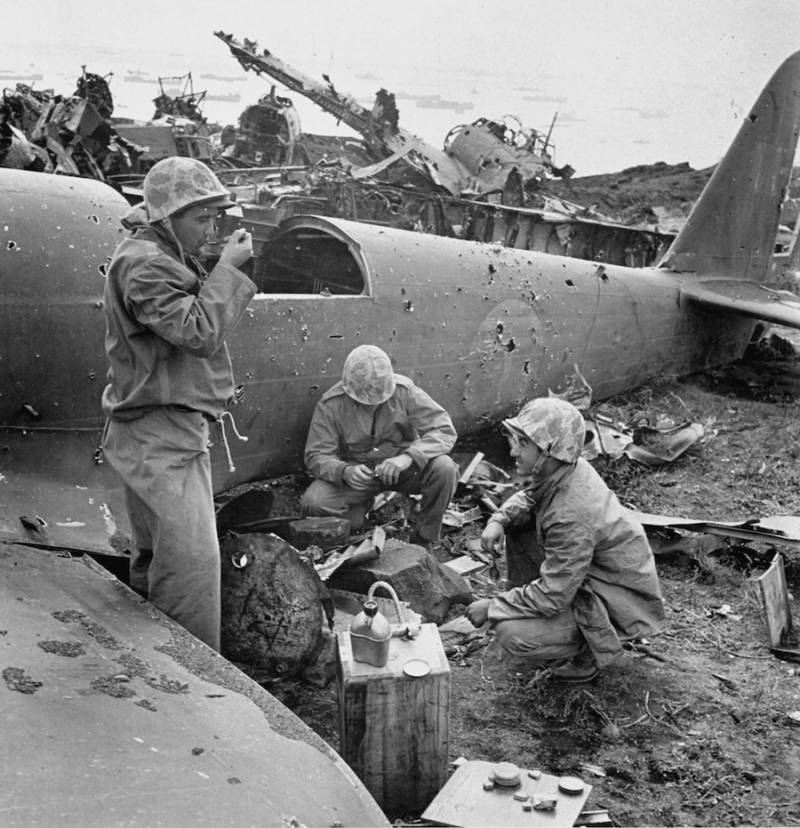
W. Eugene Smith/The LIFE Picture Collection/Getty Images American soldiers taking a break and eating next to wreckage of aircraft during lull in the Battle of Iwo Jima.
The films are not without their critics, however. Acclaimed director Spike Lee criticized Eastwood's decision to omit the Black Marines who were involved in the island battle.
"Clint Eastwood made two films about Iwo Jima that ran for more than four hours total, and there was not one Negro actor on the screen," Lee remarked during a press conference to promote his own war film, Miracle At St. Anna.
"If you reporters had any balls you'd ask him why. There's no way I know why he did that....But I know it was pointed out to him and that he could have changed it. It's not like he didn't know."
Despite the missing African-American soldiers, historians say Eastwood's films are fairly accurate. Chuck Melson, chief historian of the U.S. Marine Corps., said that most of the war scenes in Flags Of Our Fathers were well-done and depicted the battlegrounds accurately, particularly the scene of the American landing on Iwo Jima.
"They could come ashore, but once they hit that black volcanic sand, they couldn't move," Melson noted. "Tanks and jeeps got stuck, and the Marines themselves were slipping and sliding and really couldn't dig into the beach, so they were wide open to Japanese guns and shellfire."
Despite the criticism, the films do a commendable job of depicting one of the most iconic battles of the Pacific War. Iwo Jima is forever enshrined in both American and Japanese cultures as a testament to the heroism — and the savagery — that characterized World War II.
After seeing these impactful images of the Battle of Iwo Jima, take a look at 28 haunting photos from the Battle of Kursk, the biggest tank battle in history. Then, learn about the Battle of Verdun, the longest battle of World War I.
cangelosibeills43.blogspot.com
Source: https://allthatsinteresting.com/battle-of-iwo-jima
Publicar un comentario for "Firebomb Dungpile Japs Again and Again and Againto Extinction"